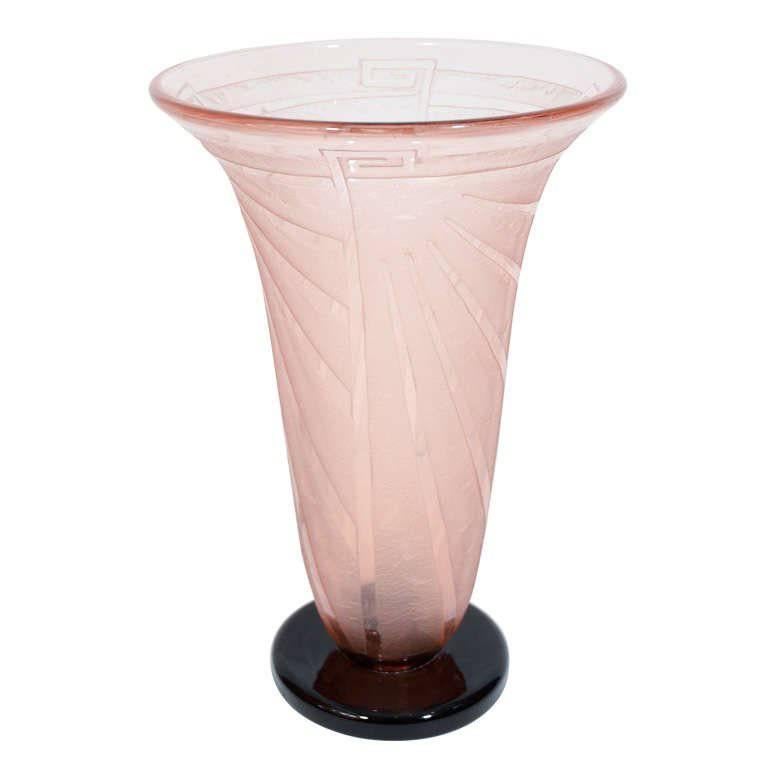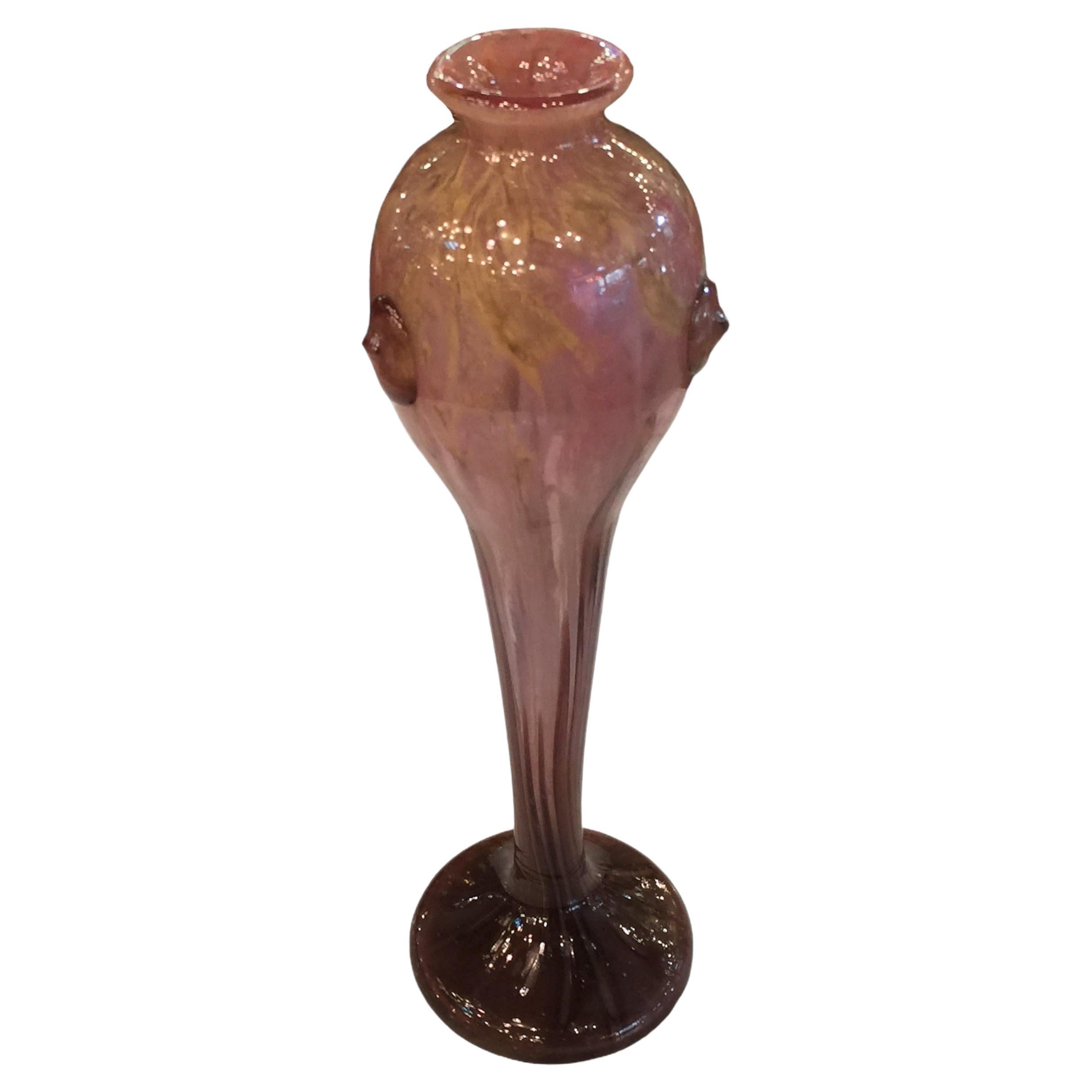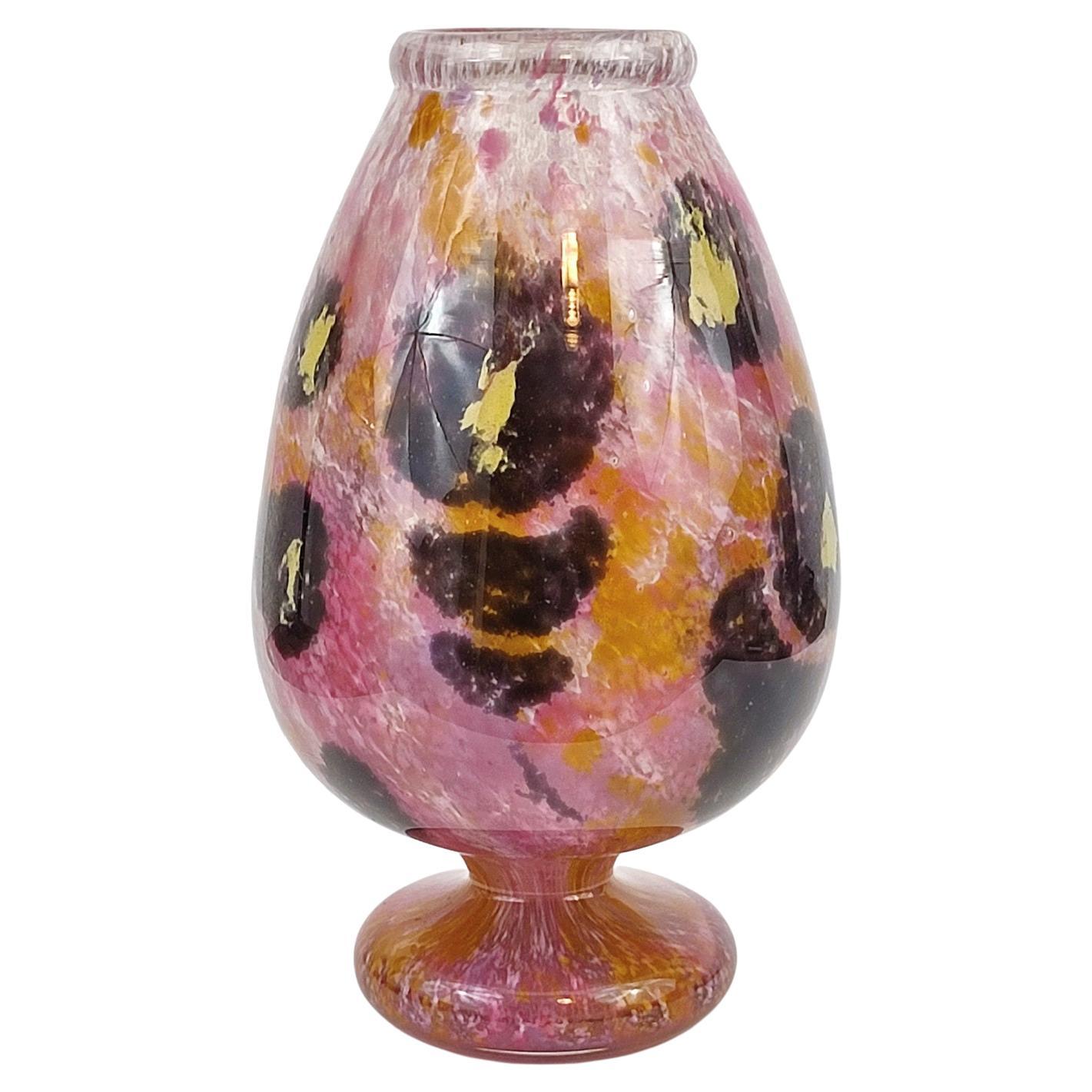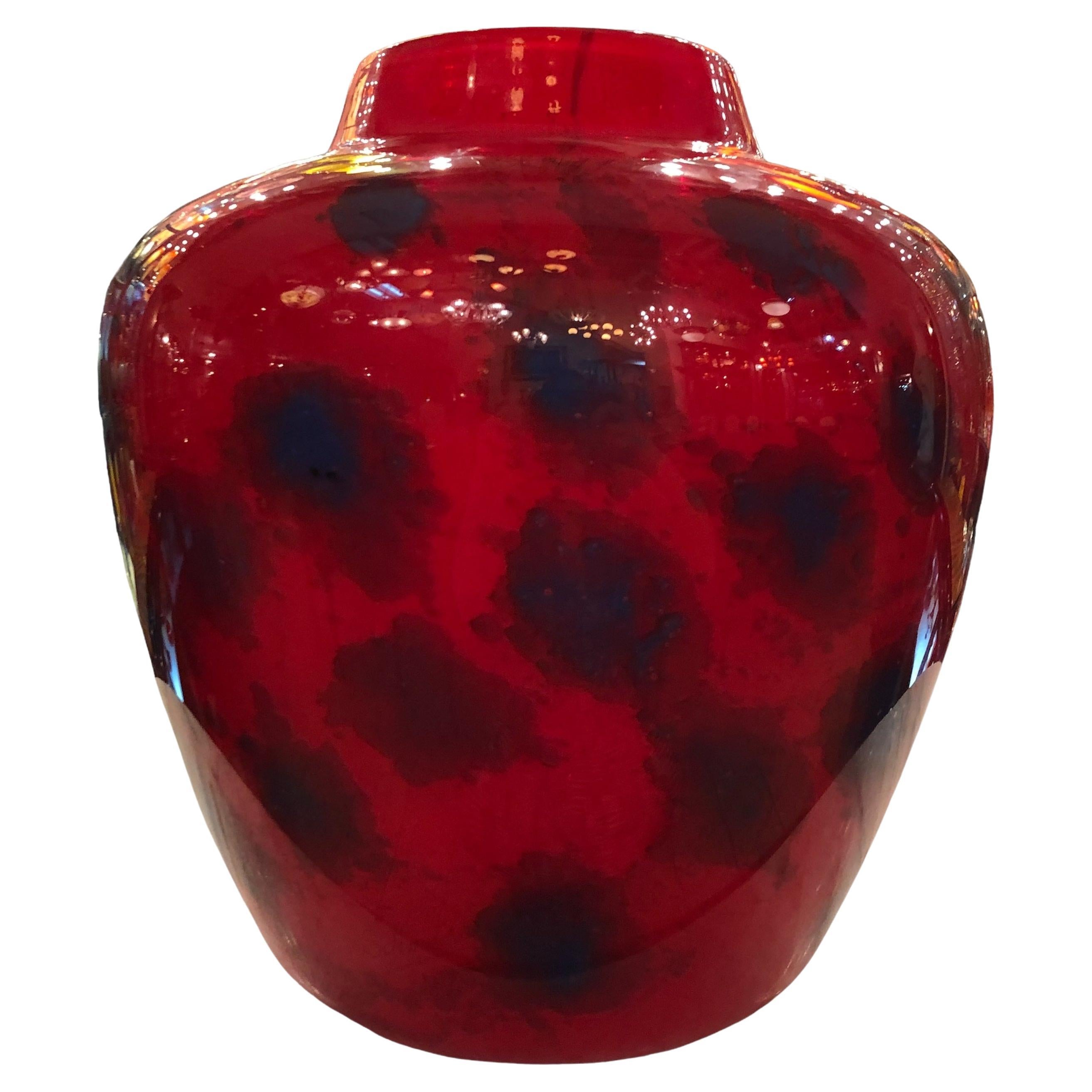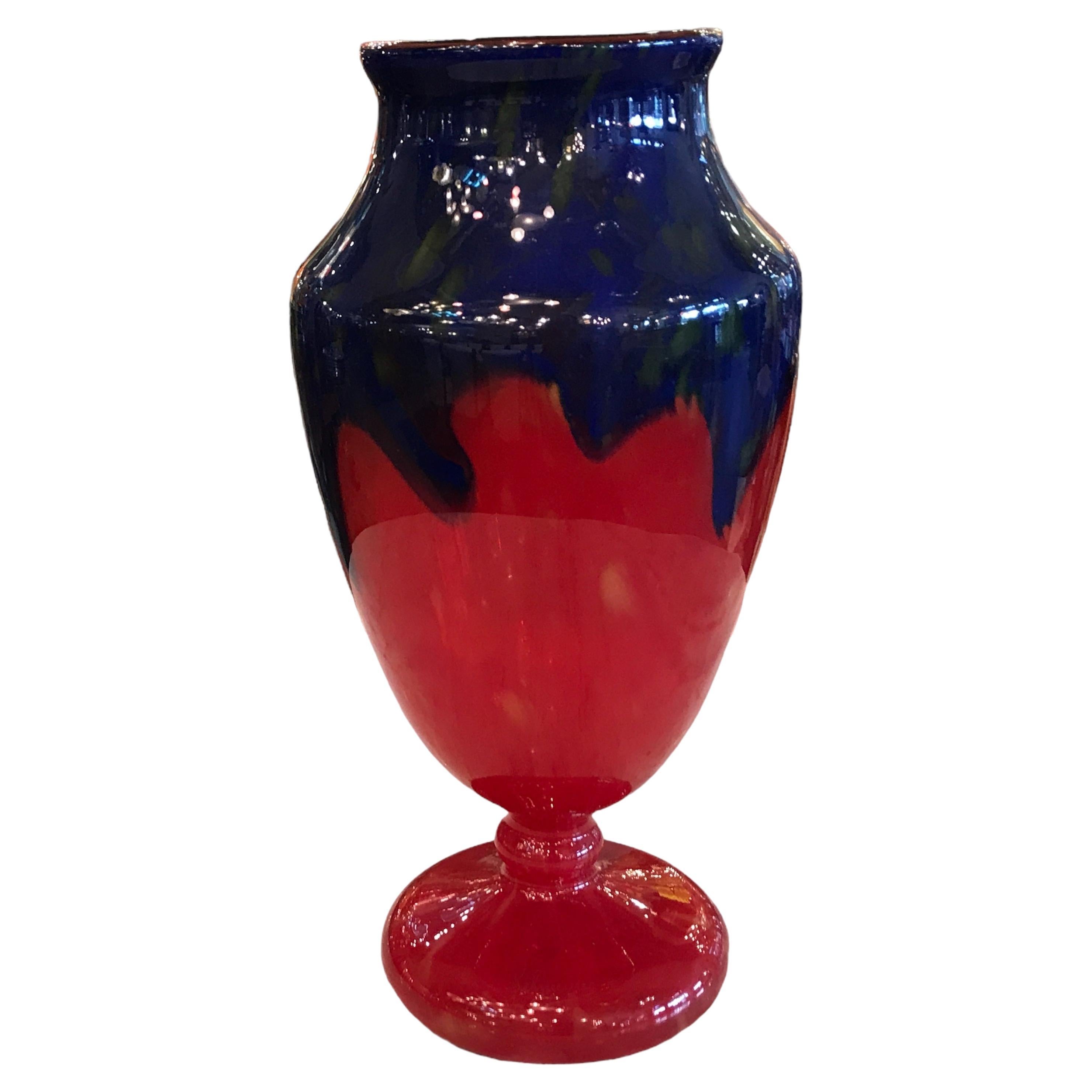Items Similar to Charles Schneider French Art Deco Vase, 1914-1918
Want more images or videos?
Request additional images or videos from the seller
1 of 7
Charles Schneider French Art Deco Vase, 1914-1918
About the Item
French Art Deco vase by Charles Schneider Epinay-sur-Seine (Paris), 1914-1918. Unusual vase colored with bright yellow and rich orange colors overlaid with a veil of dark brown/black. Wrought-iron base made by Schneider in a workshop of the factory decorated with three glass balls in the colors of the piece. Measures: Height : 7.3"(18.5cm), Overall diameter : 5.9"(15cm), Diameter of the upper glass part : 5.5"(14cm). Signed "Schneider" on the glass ball base (see photo). Very good condition, just a few small scratches (to be accurate). An unusual and beautiful piece.
About Schneider:
Charles Schneider was born in Chateau-Thierry, near Paris, on 23rd February 1881. At an early age he moved with his family to Nancy, the artistic center of France.
His brother, Ernest Schneider (1877-1937), started working for Daum in 1903 as clerk. Charles had started an artistic career and was already active at Daum since 1898. He performed his practical training in the engraving and decorating workshop, but he also took drawing and modelling lessons with Henri Berge. Concurrently, he studied the Ecole des Beaux-Arts in Nancy.
In 1904, he went to the Ecole Nationale des Beaux-Arts in Paris and studied painting and medal engraving. During this period, he made bronze art objects in the pure Art Nouveau style, all signed "CH. SCHNEIDER Nancy". From 1906, he regularly exhibited in the Engraving section of the Salon de la Societe des Artistes Francais and he was twice awarded a prize.
In 1913, the brothers decided to start their own business and bought a small glass factory, specialising in electric light bulbs, in association with a friend Henri Wolf, at Epinay-sur-Seine. This factory was known as ‘Schneider Freres & Wolf’. The new glassworks production started with, among others, a group of about twenty workers enticed away from the Daum manufacture. At the outbreak of the World War I, the firm's activity had to be stopped and the glassworks closed by the end of 1914.
Ernest and Charles were demobbed in 1917 and the factory re-opened under the name "Societe Anonyme des Verreries Schneider". At this time, public taste still favoured the Art Nouveau style, and the factory produced mainly ‘cameo’ glass with floral and animal designs, and vases with applied handles and bubbles. Apart from the introduction of art glass, half of the production was of commercial drinking glasses. In 1918, fire destroyed the studios at Galle and a group of artists went to Schneider’s to continue their production for Galle. This period was of great importance to Charles Schneider because he acquired the technique of ‘marqueterie de verre’ from Galle’s artists. This technique, similar to marquetry in wood, is where the design is carved out of a vase and filled with colored glass.
The big black-footed bowls are one of the first types of art glass made by the Schneider factory. These designs give only a partial idea, however, of the variety of bowls of this type that were produced for at least he next six years. During the first period, they had a satinic finish (1918-1921). Later, they were polished to a smooth, brilliant surface.
In this period, Schneider started producing top-of-line pieces with intercalary motifs or with applied patterns requiring a thorough mastery of the execution technique on the part of the glassmaker. Mention should be made of the pieces with wheel-carved patterns, such as the "Raisins noirs" series, and the "Pavots" or "Camelias" medallion series.
Some of the factory's most interesting models during the early period were designed by Gaston Hoffman between 1918 and 1921. His pieces are not signed with his name, since he was a salaried employee of the firm. Most of his models are in the top rank of the factory's production.
By 1920, the factory was working at full capacity making mainly art glass. In 1921, Schneider started new trade marks for his cameo glass, signing it ‘Le Verre Français’ or ‘Charder’. Sometimes a vase or lamp would bear both signatures. The idea was to popularise art glass and make it more accessible to the public.
Le Verre Français was mainly sold at department stores like Galeries Lafayette, Le Printemps and Le Bon Marche. Pieces signed ‘Schneider’ were sold by specialised art shops such as Delvaux, Rouard, La Vase Etrusque and Le Grand Depot. Le Verre Français was made exclusively using the technique of acid etching, which gave good quality at a low price. The technique of wheel engraving through different layers of glass was used only for special pieces.
After the 1925 exhibition, various new designs were created and the factory expanded to employ about 500 workers. Blank glass was also supplied to art shops (Delvaux etc.) to be decorated (enamelled, painted etc.) by their own artists, and commissions were received from perfumery companieslike Coty. At this time, the company was at its peak due to the good designs of the previous years, such as the new style created in 1920 using new shapes and contrasting colors by applying black foot and handles to brightly coloured vases and coupes, thus giving them a dramatic effect.
Always innovative, Schneider created a new technique of ‘colored powders’ whereby the pulverised glass was mixed with metal oxides to obtain different colours and then spread on a flat surface. Most of Schneider’s art vases and lamps were exported to America.
After the Wall Street crash of 1929 demand dwindled and the factory started to decline. During the 1930s production of art glass was down to a few pieces a day as they concentrated on making simple designs with less colours for the local market.
Attempts were made to save the firm. But Ernest had been seriously ill since the end of the 1920s and was of no help. He died in June 1937, one month after the liquidation of the "Verreries Schneider". In 1940, during the war, the factory was requisitioned by the German troops and used as a restaurant.
In 1950, Charles Schneider and his son founded a new glassworks at Epinay-sur-Seine, named "Cristalleries Schneider", which was later transferred to Lloris after an accident caused by a gas explosion. Like the old Schneider factory, this one specialized in free-blown glass. Following the artistic trend of the 1950s, the glassworks produced glass sculptures, crystal vases (sometimes bubbled and colored), ashtrays, clock frames, candlesticks and fruit bowls. But this time, the glass was lead crystal, which had come back into favor in France during the 1930s after being revived in Scandinavia. It was no longer cut, but worked almost exclusively by free-blowing and drawing. All the productions were signed "Schneider France".
Charles Schneider’s died in 1952 and the factory was closed in 1981.
- Similar to:Studio Art Deco (Designer)
- Dimensions:Height: 7.29 in (18.5 cm)Diameter: 5.91 in (15 cm)
- Style:Art Deco (Of the Period)
- Materials and Techniques:
- Place of Origin:
- Period:
- Date of Manufacture:1924-1926
- Condition:
- Seller Location:Saint-Amans-des-Cots, FR
- Reference Number:1stDibs: LU2312336977412
About the Seller
5.0
Platinum Seller
These expertly vetted sellers are 1stDibs' most experienced sellers and are rated highest by our customers.
Established in 2003
1stDibs seller since 2016
403 sales on 1stDibs
Typical response time: <1 hour
- ShippingRetrieving quote...Ships From: Saint-Amans-des-Cots, France
- Return PolicyA return for this item may be initiated within 2 days of delivery.
More From This SellerView All
- Oreot Large French Art Deco Glass Vase, 1920By Studio Art DecoLocated in Saint-Amans-des-Cots, FRLarge enameled glass vase by Oreot (Paris), France, 1920s. Close to the Rene Lalique and Andre Hunebelle works. Height : 12"(30.5cm), Diameter : 10.6"(27cm). Signed "Oreot" at the bo...Category
Vintage 1920s French Art Deco Vases
MaterialsGlass
- Adrien Mazoyer French Art Deco Enameled Flower Vase, 1920sBy Studio Art DecoLocated in Saint-Amans-des-Cots, FREnameled glass vase by Adrien Mazoyer (1887-1950), Moulins, France, 1920s. Richly enameled large roses. Measures: Height : 6.9"(17.5cm), Diameter : 6.5"(16.5cm). Signed "A.Mazoyer Fr...Category
Vintage 1920s French Art Deco Vases
MaterialsArt Glass
- Adrien Mazoyer French Art Deco Enameled Daisy Vase, 1920sBy Studio Art DecoLocated in Saint-Amans-des-Cots, FREnameled art glass vase by Adrien Mazoyer (1887-1950), Moulins, France, 1920s. Richly enameled large daisies. Measures: height : 4.7" (12cm), diameter : 9.45" (24cm). Signed "A.Mazoy...Category
Vintage 1920s French Art Deco Vases
MaterialsArt Glass
- Muller Freres Large French Art Deco Sparrows Frosted Glass Vase, 1920By Studio Art DecoLocated in Saint-Amans-des-Cots, FRLarge frosted glass vase by Muller Frères (Luneville), France, ca.1925. 21 sparrows in trees. Slight blue patina in places to accentuate the reliefs. Measures: Height : 11.1"(28.2cm)...Category
Vintage 1920s French Art Deco Vases
MaterialsGlass
- Daum Pierre D'Avesn Large French Art Deco Fish Vase, Early 1930sBy Studio Art DecoLocated in Saint-Amans-des-Cots, FRLarge Freanch Art Deco vase by Pierre D'Avesn at Daum's (Croismare, Nancy), France, early 1930s. Decor of three fishes swimming in the middle of algae. Thick molded-pressed satiny gl...Category
Vintage 1930s French Art Deco Vases
MaterialsGlass
- Daum Nancy French Art Deco Vase, 1930sBy DaumLocated in Saint-Amans-des-Cots, FRFrench Art Deco glass vase by Daum (Nancy), France, 1930s. Thick blown and bubbled glass vase. Color : green. Height : 7.7"(19.5cm), Diameter : 7.1"(18cm). Signed "Daum + Nancy Franc...Category
Vintage 1930s French Art Deco Vases
MaterialsGlass
You May Also Like
- Charles Schneider, Art Deco Glass Vase, France, C. 1930By Charles SchneiderLocated in New York, NYArt Deco acid-etched smoked glass vase by Charles Schneider. Signed "Schneider, France". Daum was founded in Nancy, France, by Jean Daum in 1878. After his death in 1885, his sons ...Category
Early 20th Century French Art Deco Glass
MaterialsGlass
- M- Vase Sign: Schneider with application, 1918, FranceBy Charles SchneiderLocated in Ciudad Autónoma Buenos Aires, CVase Sign: Schneider Schneider Charles Schneider (1881-1953) studied art in two of most prestigious French school of the Arts. First in the School of Fine Arts in Nancy, then in the...Category
Vintage 1910s French Art Deco Glass
MaterialsArt Glass
- Charles Schneider Glass Vase, FranceBy Charles SchneiderLocated in Paris, FRCharles Schneider Glass vase. Signed.Category
20th Century French Glass
MaterialsGlass
- Schneider Art Deco "Jade" VaseBy Charles SchneiderLocated in Bochum, NRWCharles Schneider, jade vase, a hard to find vase of the Schneider brand, which used 32 shades variations, more expensive and more exclusive, than Le Verre Francais, which used only ...Category
Early 20th Century French Art Deco Vases
MaterialsBlown Glass
- Vase Sign: Schneider ( Jade Decoration ), France, 1922, Art DecoBy Charles SchneiderLocated in Ciudad Autónoma Buenos Aires, CVase Sign: Schneider Charles Schneider (1881-1953) studied art in two of most prestigious French school of the Arts. First in the School of Fine Arts in Nancy, then in the elite Eco...Category
Vintage 1920s French Art Deco Glass
MaterialsArt Glass
- Vase Schneider, France, Jade decoration, Style: Art Deco, 1922By Charles SchneiderLocated in Ciudad Autónoma Buenos Aires, CVase Sign: Schneider ( Jade Decoration ) Schneider Charles Schneider (1881-1953) studied art in two of most prestigious French school of the Arts. First in the School of Fine Arts in...Category
Vintage 1920s French Art Deco Glass
MaterialsArt Glass
Recently Viewed
View AllMore Ways To Browse
Daum Crystal Deco
Bubble Wall Sculpture
Daum Lead Crystal
French Art Glass Deco Vase Vase
Art Deco Foot Lamp
Nouveau Clock
Art Nouveau Glass Vase With Handles
French Glass Vase Bubble
Wrought Iron Street Light
Art Deco Lamp Schneider
Clocks France 1920
Electric Fire
Art Deco French Wall Clock
Bulb Vase Lamp
Early Electric Design Studio
Bronze Animal Lamp
Big Sur Photo
Wolfers Freres
